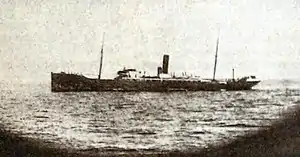Action of 16 January 1916
The Action of 16 January 1916 was a single ship action of World War I. It was fought between a German auxiliary cruiser and a UK cargo ship off the Portuguese islands of Madeira in the Atlantic Ocean.
| Action of 16 January 1916 | |||||||
|---|---|---|---|---|---|---|---|
| Part of the First World War | |||||||
 SMS Mowe, circa January 1916 | |||||||
| |||||||
| Belligerents | |||||||
|
|
| ||||||
| Commanders and leaders | |||||||
|
|
| ||||||
| Strength | |||||||
| 1 auxiliary cruiser | 1 merchant steamer | ||||||
| Casualties and losses | |||||||
| None |
18 killed 5 wounded 3 captured 1 merchant steamer scuttled | ||||||
Background
Most successful of German commerce raiders during the war, SMS Möwe was commanded by Korvettenkapitän (corvette captain) Nikolaus zu Dohna-Schlodien and was assigned to duty in the Atlantic. Möwe was launched as a cargo ship in 1914 and converted in 1915. She displaced 9,800 tons and was armed with four 150-milimetre guns, one 105-millimetre gun and two torpedo tubes. Her opponent was the 5,816 gross ton Clan Line ship Clan Mactavish, defensively armed with one gun on her stern and laden with fur, meat and cotton.
Action
Möwe was steaming about 120 miles south of Madeira on 16 January 1916, with the merchant steamer Appam, a ship previously captured by the Germans who installed a prize crew and transferred several dozen prisoners of war to. At sunset, lookouts aboard Möwe sighted smoke on the horizon, indicating a ship. Kapitän Dohna-Schlodien ordered Appam to remain behind while he went to investigate. Several minutes later, at about 21:00, Möwe came within a distance to where her lookouts could make out that the smoke had originated from a large merchant ship, later identified as Clan Mactavish.
By the time Möwe came within close range it was dark, so Möwe approached cautiously. Using a signal lamp, Dohna-Schlodien asked the cargo ship's name. Clan Mactavish replied by asking that the German ship first identify herself. Dohna-Schlodien signalled that his ship was Author, a Harrison Line ship sailing from Liverpool to Natal. Möwe reportedly looked very similar to Author, which had been sunk by the German Navy a few weeks earlier. Clan Mactavish then signalled her name and that they were returning to Britain from Australia.
Havingt identified the British ship, Dohna-Schlodien crossed her bow and ordered her to halt. Instead of complying, Clan Mactavish changed course and increased speed, hoping to outrun the raider. Möwe fired warning shots and gave chase. Clan Mactavish returned fire with her single gun, but repeatedly missed and the German ship suffered no damage or casualties. Möwe fired salvoes with her four 150 mm guns. Clan Mactavish sent wireless telegraph distress signals that were received by the armoured cruiser HMS Essex. However, the telegraphist aboard Essex failed to tell his superiors, so no help was sent. After taking several hits topside, Clan Mactavish caught fire and her captain signalled his surrender to Möwe. Möwe then manoeuvred for boarding.
All of the German rounds were hits apart from the warning shots. A boarding party from Möwe seized Clan Mactavish and removed her surviving crew as prisoners. 18 of her crew had been killed in battle or just after and five others had been wounded. Clan Mactavish's captain was a Royal Navy reservist and her gun was crewed by two Royal Navy gunners. The remainder of her crew were civilians. Theree was now now a total of more than 500 Allied prisoners of war on Möwe and Appam.
The boarding party scuttled Clan Mactavish with explosive charges.
Aftermath
After sinking Clan Mactavish, Möwe reunited with Appam and set a westward course to avoid any Royal Navy cruisers in the area. Two cruisers were just over 100 mi (87 nmi; 160 km) away and could have intercepted Möwe had the telegraphist aboard Essex responded.
Möwe went on to sink several more Allied ships before returning home. Upon arrival, Kapitän Dohna-Schlodien was awarded the Iron Cross second class. On her second cruise, Möwe sank another single-gun Allied merchant ship in the mid-Atlantic in the action of 10 March 1917.
See also
References
Further reading
- Hoyt, Edwin P (1970). Elusive Seagull. Frewin. ISBN 0-09-101570-7.